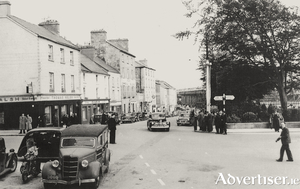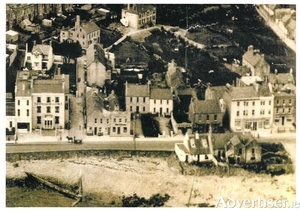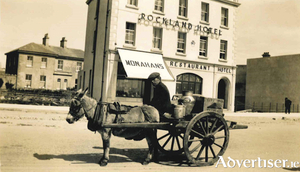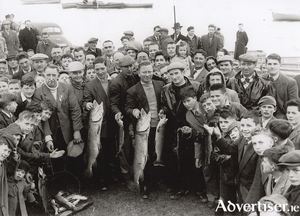Search Results for 'Rockland Hotel'
4 results found.
Traffic changes in Galway

When the city was being constructed in medieval times, the streets and even the lanes must have appeared wide and spacious. The only kind of traffic they would have experienced then would have been pedestrian, horse or donkey and cart and maybe the odd wheelbarrow. We have two images for you today of the east side of Eyre Square the first (courtesy the National Library) dates from c1890 and shows that type of traffic; The second (courtesy Galway County Library) shows the same area with motorised traffic. Since the latter was taken, the population has grown by 6 or 7 times, and of course, the traffic volumes have increased accordingly. So the Corporation had to make occasional changes to the bye-laws in relation to traffic.
Upper Salthill, a bird’s eye view, c1945

This aerial photograph was taken c1945. On the left you can see the Eglinton Hotel which was originally built in the 1860s. Up to that time, Salthill was a small village that included Lenaboy Avenue and the area between what we know as Seapoint and the Bal. The construction of the Eglinton was on a scale not seen before in Salthill, and it extended the village to the west. It came at a time when locals were beginning to promote the village as a resort, a destination for tourists.
The Rockland Hotel

In 1923 Forster Park, the residence of Gerald Cloherty, clerk of the crown and peace for County Galway, sold his house to surgeon Michael O’Malley. In July 1935 the Connacht Tribune reported that the purchase of plots in front of the house recently occupied by Dr O’Malley, and the question of allowing the purchasers to proceed with the building immediately, or to force them to defer until the road along the Promenade had been widened, was the subject of a long discussion at the Urban District Council meeting.
Bráithreacht na Coiribe

When a small group of anglers who regularly fished the lower lake were arranging a function for themselves in 1953, they decided to form an angling association as well. The objectives of the association were the promotion of good fellowship among anglers, the fostering of improved angling conditions, and the maintenance of free fishing. They called themselves the Brotherhood of the Corrib, or Bráithreacht na Coiribe.

